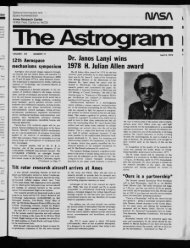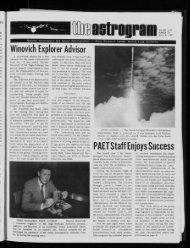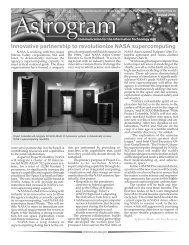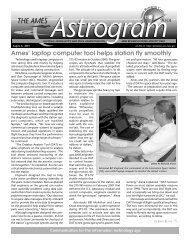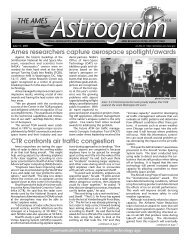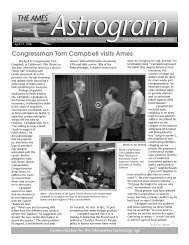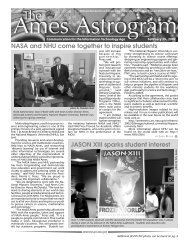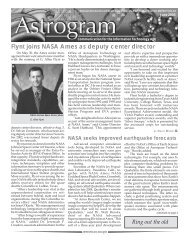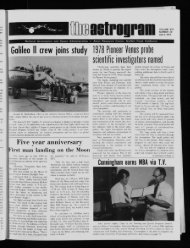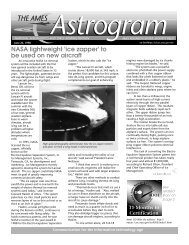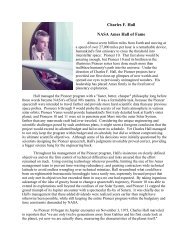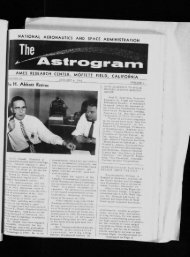1972 December - NASA Ames History Office
1972 December - NASA Ames History Office
1972 December - NASA Ames History Office
Create successful ePaper yourself
Turn your PDF publications into a flip-book with our unique Google optimized e-Paper software.
A review 0f.<strong>Ames</strong>’ <strong>1972</strong> major accomplishments<br />
mice experiment<br />
-~ The <strong>Ames</strong> BK)CoI-H~" experiment was successfully<br />
flown on Apollo 17: the experiment<br />
involved sending six pocket mice intt~ space<br />
to determine the effects of high energy heavy<br />
particle radiation on the brain. Sinee pocket<br />
mice had never before been exposed to the<br />
Apollo environment, successful implementation<br />
of the experiment required intensive preliminary<br />
research studies on the animals.<br />
blood flow sensors<br />
Noninvasive Doppler ultrasonic sensorswere<br />
developed for monitoring eye-level blood flow.<br />
The technique can be used to warn of impending<br />
"blackout" during reentry or aircraft flight conditions.<br />
<strong>Ames</strong> to build wind tunnel sound<br />
microscope breakthrough<br />
.:~ A new annular aperture has been developed<br />
for existing electron mieroscopes which, for the<br />
first time, permits observation c)f mieroseopie<br />
details as small as one Angstrom.<br />
Pioneer 10<br />
-~ On March 2, <strong>1972</strong>, Pioneer l0 w~s successfully<br />
launched on its fly-by missionpast Jupiter,<br />
The spacecraft is now more than haKway through<br />
the asteroid beltand is performing satisf mtorily.<br />
The scientific instruments on board Pioneer 10<br />
are returning data on particles and fields in the<br />
interplanetary medium and on the nature ()f the<br />
asteroid belt. Pioneer 10 is the first spacecraft<br />
to explore the regions beyond the orbit of Mars<br />
and wii1 be the first man-made object to leave the<br />
solar system.<br />
aatrogram<br />
barrier<br />
Construction of a wind tunnelen- Some locations of the surrounding<br />
closure to act :is a sound barrier<br />
for noise generated by a 200,000<br />
hc~rsepower compressor at <strong>Ames</strong><br />
wit1 begin this week under a half-<br />
million dollar eontractwith the Peopl,:s<br />
Construction Company of Mr.<br />
\ iew.<br />
The eight month construction<br />
project is to erect an acoustically<br />
Sealed metal shell around the <strong>Ames</strong><br />
11-Foot Transonic Wind "Funnel to<br />
trip noise that might reach nearby<br />
residents,<br />
A recent study<br />
showed that<br />
the blades of a 24<br />
foot diameter<br />
compressor, while<br />
driving air<br />
through the tunnel<br />
test chamber<br />
al about six-tenths<br />
the speed of<br />
Sound, create a sound pitched about<br />
one untave above middle C,<br />
When ’atmospheric conditions are<br />
JUst right, the sound can be heard<br />
above the ambient noise level in<br />
community.This ]s particularly true<br />
because the ear ~s especially sensitive<br />
to this frequency.<br />
The study showed that the enclosure<br />
design will significantly reduce<br />
noise penetration into the sur-<br />
rounding community from ]0 to 30<br />
decibels {amea sure of sound levels).<br />
This means the sound will be beleu<br />
the normal existing noise level in<br />
the community.<br />
The ll-Foot Tunnel is one of<br />
the special test devices fop aero-<br />
nautical research at .\lnes and is<br />
considered a national facility by virtue<br />
of its wide use by the military<br />
services, industry and others<br />
engaged in advanced aeronautical<br />
research. The tunnei gives aerodynamicists<br />
the ability to study aircraft<br />
behavior at critical speeds<br />
before actual flight<br />
RECENT COURSE CHANGE<br />
Pioneer 10 to<br />
pass behind 10<br />
A recent course adjustment of<br />
P~oneer 10, en route to JupJter,<br />
will hopefully cause the spacecraft<br />
to pass behind the planet’s orange<br />
satellite, to. This would allow scientists<br />
to measure lo’s atmosphere,<br />
if any’, as spacecraft radio signals<br />
calculate its characteristics.<br />
Io is about the size of the Earth’s<br />
Moon. ~en through a telescope it is<br />
distinctly orange, and is the most<br />
reflective object in the solar system.<br />
Io is brighter than normal for<br />
about ten minutes after it emerges<br />
from Jupiter’s shadow, and scien-<br />
tists believe this means there is<br />
a temporary deposit of ice when lo<br />
is in Jupiter’s shadow and this melts<br />
adam when lo is back in sunlight.<br />
yawed wing<br />
The yaweu-wing concept v.as<br />
proposed by Dr. fl.T. Jones as a<br />
way to achieve supersonic transport<br />
capability without the penalties<br />
of high fuel consumption and noise<br />
assoeaated with conventional SST<br />
aircraft. The design has a conventional<br />
straight wing during takeoff<br />
and, as the aircraft reaches the<br />
speed and altitude where swept wings<br />
ar~- elfieient, the entire wing rotates<br />
about 45 degrees. Extensive wind<br />
tunnel tests this past year have<br />
vet\fred the expected improvement<br />
in ~eredynamic efficiency at transonic<br />
flight speeds.<br />
<strong>Ames</strong> Earth Resources Survey<br />
Aircraft assLsted skate and local<br />
agencqcs in disaster assessment and<br />
fire fighting. Crews fighting the Molera-Big<br />
Sur fire were able to leave<br />
the fire lines one day earlier than<br />
expected because of the aerial photo-<br />
graphs obtained by <strong>Ames</strong>.<br />
In conjunction with Pan Am erican<br />
.\irlincs, Anles researchers conducted<br />
~ successful simulator and<br />
flight pr>gram m a Boeing 747 airplane<br />
leading to FAA certification<br />
of a head-up display designed to<br />
prevent short-landing accidents.<br />
~(~ The Augmentor ~3. ing Jet STOL<br />
Research Aircraft iModified C-81<br />
made its first flight on May 1 at<br />
t!~e Boeing Company in Seattle and<br />
was delivered to <strong>Ames</strong> on July 31.<br />
In August, a flight test program was<br />
initiated to prove the augmenter wing<br />
concept. The aircraft has been flown<br />
approximalely 50 hours in which<br />
STOL takeoffs have beenaehieved in<br />
approximately 650 feet of ground<br />
roll.<br />
pass through it.<br />
Trajectory analyses show that a<br />
brief firing of spacecraft thrusters<br />
September 19, <strong>1972</strong>, sped up the<br />
Pioneer by .745 feet per second.<br />
This means tlx~t Pioneer lff will honors and awards<br />
arrwe at Jupiter ~7.2 mfnutes ear-<br />
-)~ Dr. Hans Mark, <strong>NASA</strong> Medal for<br />
her -- at just the right time for<br />
Distinguished Service; Dr. Klaus<br />
1o to pass bet~en it and the Earth.<br />
Heinemann, <strong>NASA</strong> Medal for Ex-<br />
1o will then t0e about aa0,400 miles<br />
ceptional Sczentific Achievement;<br />
awa3 from the spacecraft.<br />
Dr. Helmut Poppa, <strong>NASA</strong> Medal for<br />
Scientists believe tktt Io may<br />
Exceptional Scientific Achievement;<br />
have an atmosphere of nitrogen or<br />
Dr. Hubert Vykukal, <strong>NASA</strong> Medal<br />
methane. Ch~,nges m Pioneer 10’s<br />
for Exeep, tioual Scientific Achieve-<br />
radio signals as they graze the satement;<br />
Dr. Charles Sonett, <strong>NASA</strong> Metl}te<br />
and pass through this atmosdal<br />
for Exceptional Scientific Aphere<br />
would allow experimenters to<br />
cheivcment; Dr. Palmer Dyal, <strong>NASA</strong><br />
Medal for Exceptional Scientific A-<br />
ehievement; Woodrou L. Cook, <strong>NASA</strong><br />
Medal for Exceptional Service;<br />
Willie L. \Vhite, Jr., <strong>NASA</strong> Eqtt~l<br />
Employment t~portunily Award;<br />
Pioneer 6-9 Team, <strong>NASA</strong> Group Achievement<br />
..\ward; C. Thomas Snyder,<br />
Dryden Fellowship; Victor L.<br />
Peterson. MI’F SLL)AN Fellowship;<br />
Charles Kubokawa, Japanese National<br />
Aerospace Laboratory Fel-<br />
lowship. (Continued on Page 3)



